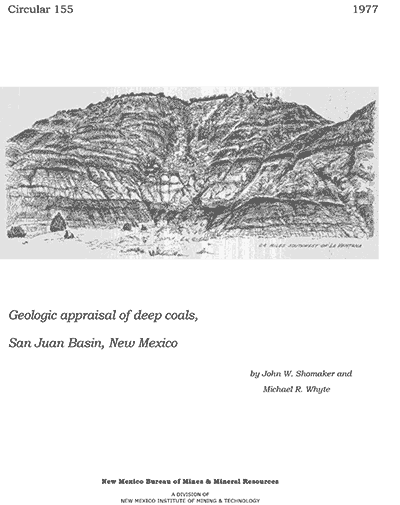
Circular 155—Geologic appraisal of deep coals, San Juan Basin, New Mexico
By J. W. Shomaker and M. R. Whyte, 1977, 39 pp., 6 tables, 13 figs., 2 appendices.

Outlines areas of Cretaceous coal resources. This report is the result of a cooperative study of the reserves of deep (250 ft or more below the surface) Cretaceous coals in the San Juan Basin of New Mexico made by the New Mexico Bureau of Mines and Mineral Resources and the U.S. Bureau of Mines under grant G-0122108, with additional funding by the New Mexico Energy Resources Board under grant 124. The objectives of the study were to outline areas of Cretaceous coals and to determine the resources available township by township. The project also sought to determine coal quality as definitely as possible and to evaluate the economic position of the coals.
The project consisted of four phases. The first phase was to verify the outcrop data and to selectively check subsurface information to see if deep coal beds could be identified with reasonable certainty. The second phase was to examine all available subsurface data, mainly the geophysical logs from petroleum test borings. The third phase was to drill two deep tests to about 1,500 ft for verifying the interpretations of the geophysical data. The drilling results were somewhat unexpected and indicated that some of the geophysical interpretations should be used with caution. The final phase was a reexamination of all of the data and a compilation of the revised estimates of the coal resources.
The Fruitland Formation contains the largest resources of deep coal in the San Juan Basin; most of these had been calculated by Fassett and Hinds, and more recent drilling has not changed their estimates significantly. This study of the deep coals beneath the Fruitland Formation is a natural extension of the program Shomaker and others who described reserves of strippable low-sulfur coal in the San Juan Basin. Records of more than 14,000 wells drilled in the San Juan Basin were examined, and all other applicable materials such as cuttings, a few core tests, and drillers' logs were utilized. The main basis for our estimates of the coal resources was 294 key wells in which the Menefee Formation was examined in detail. Partial sections from other oil and gas test holes were also studied.
The deep coals of the San Juan Basin are the result of numerous transgressive
and regressive sequences of the Cretaceous epeiric sea. These Cretaceous
coals originated from related landward coal swamps with a general north
50–60º west trend. Each landward coal swamp contains a few million
to a few tens of millions of tons of high volatile subbituminous to bituminous
coal. The Fruitland Formation represents the last regressive sequence of
the Cretaceous epeiric sea and contains some 200 billion tons of coal in
beds more than 2 ft thick at depths to 4,500 ft. As received, Btu values
are from 9,000 to 13,000 with a low moisture content ranging from 2 to 6%.
The ash content of the coal is high (10% to more than 30%). A total resource
of 12 billion tons of coal is established for the Menefee Formation, in
beds more than 2 ft thick with depths of as much as 6,000 ft. The average
heating value is 9,860 Btu per pound, with an average ash content of 12%.
Under present economic conditions underground mining of the deep coals of
the San Juan Basin is not practical. Some forms of in situ gasification
or liquefaction appears to be the most promising method of economic development.
$6.25
Buy
Now
Also available as a free download.
Download
| File Name | Size | Last Modified |
|---|---|---|
| Circular-155.pdf | 2.29 MB | 01/11/2021 03:11:28 PM |



